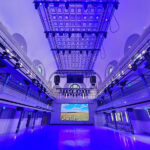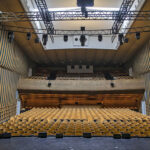 America saw one of its most difficult economic eras in the 1930s. In the wake of the stock market crash of 1929, the Great Depression put an effective halt to the boom-time spending of the previous two decades. Oddly, the movie industry was one of few to not only survive, but flourish, during the thirties. Wikipedia (www.wikipedia.org), the online encyclopedia, has this to say about the trend:
America saw one of its most difficult economic eras in the 1930s. In the wake of the stock market crash of 1929, the Great Depression put an effective halt to the boom-time spending of the previous two decades. Oddly, the movie industry was one of few to not only survive, but flourish, during the thirties. Wikipedia (www.wikipedia.org), the online encyclopedia, has this to say about the trend:
“The emergence of sound films in the late 1920s, combined with the escapism that film provided to a nation down on its luck, made the film industry one of the few that succeeded in profits and in setting a national mood.”
So it should come as no surprise that some of the most beautiful and ornate theaters were built during an otherwise pennywise period.
 For the next 40 years theatres such as the Paramount, in Charlottesville, Virginia, were community epicenters. Each week, thousands of people would come to enjoy the latest vaudeville act, musical artist or gangster movie.
For the next 40 years theatres such as the Paramount, in Charlottesville, Virginia, were community epicenters. Each week, thousands of people would come to enjoy the latest vaudeville act, musical artist or gangster movie.
The Paramount was created by Chicago architectural firm Rapp & Rapp, architects of the Paramount-Publix chain and its flagship Times Square Theater in Manhattan.
From the Paramount’s web site: “With its octagonal auditorium chamber, delicate detailing, and neoclassical grandeur, the theatre honors Charlottesville’s most famous son, Thomas Jefferson. Through details like painted tapestries, exquisite plaster moldings, and brass chandeliers, C.W. and George Rapp created a theatre unlike any other they would design— one truly reflective of the community it would call home.”
A Vaudeville Icon is Saved
As the technology of both stage and cinema advanced, the movie houses of the twenties and thirties eventually became outmoded.
In 1974, the doors to the Paramount were chained, and the theatre was all but condemned by the community around it. As the building deteriorated, graffiti and vandalism appeared like age lines on a forgotten and aging starlet. For the next two decades, the once stately movie house suffered constant threats of demolition, until a non-profit group purchased the landmark in 1992.
With a grant from the city, the new owners began their re-building effort with a full restoration of the façade and Main Street marquee in an effort to maximize public awareness of the project.
Once the lights were shining on the outside, it was time to turn to the interior. District of Columbia-based architects Martinez & Johnson were brought on to handle the $16.2 million project in association with the local firm Bushman Dreyfus Architects.
Plans were made to restore the Paramount to its former glory while expanding the facilities to serve as a regional performing arts facility and cinema.
Barry Gawinski is a systems integrator with Barbizon Lighting. In an e-mail to PLSN, he said, “When Barbizon Capitol was first invited to work on the Paramount Theater in Charlottesville, the renovation had just begun and we walked onto what we thought was a typical jobsite. After a few minutes onsite it was clear that this was going to be a very special project.
“Besides the usual construction chaos and debris, the theatre was showing significant signs of damage from its years of neglect. There was graffiti on the walls, the murals were dirty and torn, but in the corner over the stage left proscenium arch there was something really out of place. It appeared as though a bright spotlight was shining through the surface soot and grime and creating a clean, bright circle. In actuality, the owners had had this section professionally restored as a fundraising tool.”
Growing Up
Michael DiBlasi, a theatrical consultant with the Minneapolis office of Schuler Shook, was with the project from the beginning, and discussed the project at length with PLSN.
“The project is bigger than the existing building they had to renovate. So there were a lot of questions as to which direction could they go, what property could they acquire, what support spaces are needed. So, that was kind of the first phase of understanding their needs, and what that meant to the building floor plan.”
Surrounded on all sides by streets and buildings, the options for expansion were very limited. In addition to the new offices, rehearsal rooms and storage areas, the team needed to find a way to expand the theatrical space in order to fit modern day traveling shows.
Through a creative combination of architecture and electric pit lifts from Gala, the team designed a stage of variable depth while adding a simple solution for transporting equipment to the basement level storage spaces.
DiBlasi said that this added its own complications. “As you do that, you greatly alter sight lines. So, the next step was to correct and improve the sight lines. So, the balcony became a steeper terrace, and the orchestra level was re-sloped and terraced. This improved the sight lines, gave them ADA accessible seating and more comfortable seating.”
In addition, the stage house was expanded vertically, allowing for full-size drops, while a new double-purchase counterweight system was installed to get the fly gallery off the ground, freeing up valuable space in the wings.
Shedding Some Light
From there, DiBlasi worked with Barbizon lighting to design and install a lighting system appropriate to the space.
Mark Fink, the project manager for Barbizon, described the process:
provided project management and supplied the dimming, rigging and audio systems for the venue, along with curtains and the motorized pit lift.
“My job was to coordinate all of those elements and to interface with the general contractor, as we were working directly for the owner of the building. So, we worked in tandem with the general contractor, and were each responsible to each other for making sure that the things the other needed to have done were done in time to complete the project.”
Not content to return the theatre to its 1930s standards, several new lighting positions were created. In addition to onstage battens, the theatre now includes a main catwalk, four side box positions, and a balcony rail.
Theatrical dimming is provided at all positions by 192 ETC Sensor dimmers while control is provided by an ETC Express console and Emphasis Server. House lighting is handled by an ETC Unison architectural control system and ETC Sensor dimming. A full package of Source Four ellipsoidals and PARs was specified, with the client making slight adjustments to the counts prior to delivery. Altman Border Lights and Ground Cycs were also provided, as well as two Lycian followspots.
Finishing Touches
Gawinski said that the some of the grant money for the project had fairly significant strings attached.
“The theatre had to raise upwards of $14 million dollars, and a substantial portion of this came in the form of a historical grant that had a fairly strict requirement: the renovated theatre needed to match, within reason, the oldest available photo of the theatre.”
To make this possible, Barbizon brought Bob Thurston of Stage Decorations on board. Thurston was responsible for turning room renderings into reality by designing and installing the elegant drapery that was the trademark of a bygone era.
Thurston said that the client came in with a vision for the hall.
“They wanted to do some special stuff with the front curtain and the side box curtains. To that end, they went out and got some decorative fabric that was about a hundred-fifty bucks a yard, which is pricy in our world.” When the hand-picked fabric showed up, it was obvious to the Stage Decorations crew that the supplier had not fire-proofed the material, an absolute requirement in any modern installation. Thurston worked with the supplier to get the fabric properly treated in time for the installation. He said, “We were kind of their advocate as far as that was concerned.”
The high sheen fabric was ultimately used to trim the bottom of the box curtains and the grand drape. The 24-inch gold fringe at the bottom of the grand drape was sourced from India. Thurston said, “It was really drop dead gorgeous.”
Thurston, who works frequently with Barbizon, spent quite a bit of time with the materials, going through mock-up stages to get the swags spaced properly, a process he says is not uncommon. “It was spectacularly beautiful fabric. It turned out to be a very nice project.”
The Rebirth of a Legend
Chad Hershner, President of the Paramount Theater, said this of the team.
When we embarked on the challenge to restore the historic Paramount Theater in Charlottesville, we knew that we needed to recruit an exemplary team of professionals. Schuler Shook’s expertise and value was evident from the day they joined the team. Michael is a problem solver. He worked with us closely to clearly understand the ultimate goal for the restored Paramount. After he understood the goal, he and his team then pulled out all the stops to make it happen.
“Barbizon was an invaluable resource and partner during the restoration process. They facilitated and managed all of the technical aspects and coordination of all of the vendors that were part of the Paramount restoration. Barry Gawinski and Mark Fink were great to work with.”
While it may not bring back the golden age of cinema, the renovated Paramount Theater is certainly a welcome re-addition to Charlottesville’s community, and will be a star for years to come.
Phil Gilbert is a freelance lighting designer / programmer. He can be reached at pgilbert@plsn.com


